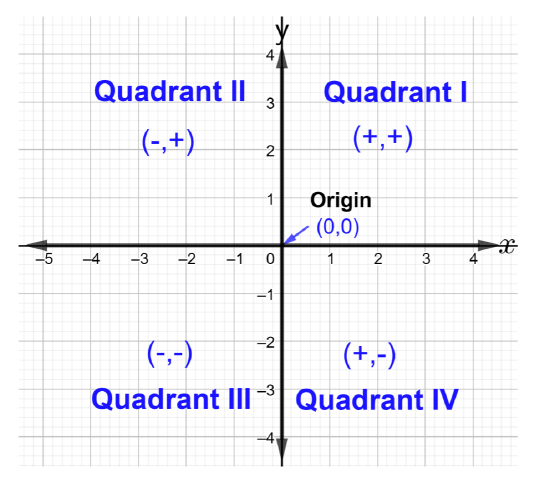2.1: Definition and Label Quadrants
- Page ID
- 45176
The Rectangular Coordinate System is also known as the Cartesian Coordinate System, is based on a grid and formed by two perpendicular number lines, the horizontal number line called the x-axis and the vertical number line called the y-axis. Every point on the rectangular coordinate system can be identified by unique x and y coordinates.
The two perpendicular number lines intersect at the point \((0, 0)\) and is called the origin. The rectangular coordinate system is divided into four regions. The regions are called quadrants and labeled in roman numerals as follows: Quadrant I, Quadrant II, Quadrant III, and Quadrant IV, as shown in the figure below

Every point in the coordinate plane corresponds to a unique ordered pair \((x, y)\), where \(x\) and \(y\) are any real numbers. The ordered pair always have the x-coordinate first (on the left) and the \(y\)-coordinate second (on the right). \((6, 4)\), \(\left(−.33, \dfrac{1}{5} \right)\), \((100, −2)\), \(\left( \sqrt{ 3}, \dfrac{1 }{2}\right )\) are few examples of ordered pairs. Read the ordered pair \((6, 4)\) as ”the point six, four” where 6 is the \(x\)-coordinate and 4 is the \(y\)-coordinate.
- What are points called that are of the form \((x, y)\)?
- Identify the coordinates of the following ordered pairs: \((−10, 0)\), \((0.5, −6)\), \(\left(\dfrac{1}{ 2} , −\dfrac{ 5 }{3} \right)\)
- Name and state the ordered pair of the point where the perpendicular axes of the rectangular coordinate system intersect.
- State the 4 regions in the rectangular coordinate system.
- Name the first coordinate in an ordered pair.
- Name the second coordinate in an ordered pair.
- What is the horizontal number line in the rectangular coordinate system?
- What is the vertical number line in the rectangular coordinate system?


